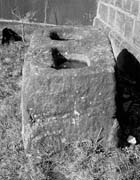Select a site alphabetically from the choices shown in the box below. Alternatively, browse sculptural examples using the Forward/Back buttons.
Chapters for this volume, along with copies of original in-text images, are available here.
Object type: Double socket-stone
Measurements:
L. 146 > 128 cm (58.25 > 57.5 in); W. 62 > 50 cm (24.5 > 19.75 in) at northern end, 57 > 47 cm (22.5 > 18.5 in) at southern end; H. 60 > 43 cm (23.5 > 17 in)
North socket: 41 x 27 cm (16 x 10.5 in); south socket: 49 x 23 cm (19.75 x 9 in); both 18 cm (7 in) deep
Stone type: Greyish yellow (5Y 8/4), medium-grained, clast-supported, quartz sandstone. The grain size ranges from 0.4 to 1.0 mm, but most are in the range 0.6 to 0.9 mm; grains, which vary from sub-angular to sub-rounded, are mostly quartz, but there are a few white ?kaolinised feldspars. Millstone Grit, Carboniferous
Plate numbers in printed volume: Ills. 506-7
Corpus volume reference: Vol 9 p. 195-6
(There may be more views or larger images available for this item. Click on the thumbnail image to view.)
The stone is roughly squared and carries two oblong socket holes.
Double sockets have a limited distribution across the borderlands of Cheshire, Lancashire, Derbyshire and Yorkshire (see Chapter V, pp. 37–8). This type, cut for square-sectioned shafts, can be paralleled within the present Corpus region at Stretford 1 and Whalley 14 (Ills. 649–50, 706–7), as well as Bolsterstone and Ecclesfield in Yorkshire and Whaley Moor in Derbyshire (Sharpe 2002, pls. on 62, 68, 107; Coatsworth 2008, ills. 249–51, 803–6). There may also be two further, now-lost, examples from Cheetham Hill and Rochdale (Crofton 1903, 46) — see Appendix C, pp. 269, 270.



